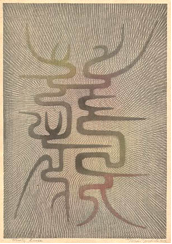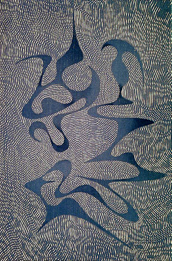Evolution of Modern Woodblock Printing:
Combining Native Roots, Western Influences, and Individual Style
In the decades following the 1950’s, the sosaku-hanga movement was subsumed into the creative output of Japanese artist working within an international art scene, but its central concern- that the print be not only an expression of the artist but also his or her sole creation from design to print- has remained a defining principal of those working with printing in the arts (Mason 386).
In 1952, one year after Toshi Yoshida produced Heirinji Temple Bell, he developed a substantial series of abstract prints.1 The context of this transformation stems from a vast but under appreciated grass roots network of artists who were later named the initiators of the sosaku-hanga or “creative print” movement. Some were struggling painters and others amateurs of the art world, but all passionately expressed themselves through the time-honored wood-block medium.
Japanese woodblock prints illustrate important events and changes for the Japanese people. In fact, Japanese woodblock prints introduced Japanese culture to the rest of the world for the first time when Westerners began seriously collecting prints in the early 19th century (Huzikake 9). During the Meiji Restoration, Japan developed as an industrialized power in the world; the woodblock prints of the era reflect those dominant sentiments. The Meiji government used ukiyo-e woodblock prints as propaganda, print makers “often [used] the bright, imported aniline dyes that matched the confident spirit of the age”(MFA Boston). However, in the 1920’s Japanese printmaking altered drastically in technique and purpose.
By this time many Japanese people considered ukiyo-e prints inferior and void of artistic value. Ukiyo-e prints became corrupt; they were commercialized, “static, over- concerned with technique, mass production and catering to popular taste” (Yutaka 307). Some believe that this corruption directly correlates with the initiation of the sosaku-hanga movement; it was in a way many people’s response to the commercialization of ukiyo-e prints. Artists of the sosaku-hanga movement, generally trained as Western-style painters, involved themselves in all stages of the print process and dedicated themselves to producing original art (Yutaka 307).2 In the beginning sosaku-hanga artists called their woodblock prints “creative” to distinguish them from those that were merely “reproductive”. Artists such as Toshi Yoshida’s father, Hiroshi Yoshida, used inventive types of impression considered by traditional ukiyo-e artists to be defective (Yoshida 89).
Sosaku-hanga artists considered printmaking “an elemental and highly personal creative act, not one to be shared with other artisans” (Fiorillo). However, creative prints did not have a monopoly on the market. At the same time the shin-hanga or “new prints” movement, led by Japanese-style printers, perpetuated the “ukiyo-e quartet” of production.3 Thus, there existed two juxtaposing styles: the ukiyo-e image, created as a product of the publisher, artist and artisan, and sosaku-hanga, where the image is carved, designed and often printed by the artist.
The early sosaku-hanga artist strove to achieve “natural realism; this was displaced by a striving for individualistic expression with more abstract and simple statements and an emphasis on composition” (Yutaka 307). Toshi Yoshida exemplifies this sentiment. In 1951 he focused on the natural elements of landscapes through more traditional prints, such as the Heirinji Temple Bell. However, while perfecting the Yoshida landscape tradition, Toshi also toiled over the prints of a separate world: abstract prints. After his father, Hiroshi Yoshida, died in 1950, Toshi embraced woodblock printing as an expressive medium more extensively. Between the years 1952-1975 Toshi produced 289 abstract prints, a seemingly disconnected jump from traditional to abstract. However, the change from traditional to abstract is not as revolutionary as one might originally think.
Traditional ukiyo-e woodcutting techniques that are ingrained in Toshi also appear in his abstract prints. Nevertheless, in the sosaku-hanga style Toshi also incorporates extensive individual expression. Practices employed while making modern prints vary drastically from artist to artist depending on the effect desired; each effect requires a different form of control on the conditions of the block when applying pigments. For example, Toshi Yoshida produced Misty Dance as a result of 17 separate impressions printed over one another.4 Numerous thin strips of uniform width were overlapped to create intricate patterns and ultimately the effect of “delicate movements of mist in an iridescent light”(Yoshida 145). Toshi’s technique is well planned and developed, and he achieved a similar effect on several occasions.
Also during 1957 Toshi printed Floating, a design printed using the same overlapping technique. Eugene Skibbe describes the technique as a product of Toshi’s understanding of how ukiyo-e artists made mosquito netting using multiple layers of printing. Toshi adapted the process to achieve an even more complex effect and the result is like looking though misty air (Skibbe 62). Toshi evidently cared deeply for expressing this complex effect because he worked hard to develop it through several prints. The care taken to make just one copy each of the two prints discussed above is immense: approximately forty impressions of precise registration.
Many of Toshi’s abstract prints are displays of disfigured shapes, though no single theme emerges among them. Toshi used a wide array of techniques; he often experiments with the way that he fills in color and suggest color. Ultimately, it is clear that Toshi Yoshida expresses emotional qualities in abstract prints influenced by the Yoshida family legacy and the history of Japanese printmaking as a whole. After all, “woodblock printing is the perfect medium for such variations on a theme. Experimentation can be controlled and reproduction exact” (Skibbe 64). Woodblock printing is a traditional base for innovative design; Toshi Yoshida carried the family legacy gracefully through the twentieth century.
Bibliography:
Fiorillo, John. http://spectacle.berkeley.edu/~fiorillo/texts/s osakutexts/sosakuhanga_intro.html. May 3, 2006 Viewing Japanese Prints . © 1999 – 2004.
Helen Merritt and Nanako Yamada ed. Guide to Modern Japanese Woodblock Prints: 1900-1997. University of Hawaii Press: Honolulu. 1992.
Huzikake S. (translated by M. G. Mori) Japanese Woodblock Prints. Board of Tourist Industry Japanese Government Railways: Tokyo. 1938.
Mason, Penelope. Revised by Dinwiddie, Donald. History of Japanese Art. Pearson Prentice Hall: Upper Saddle River, NJ. 2005.
MFA Boston. http://www.mfa.org/exhibitions/sub.asp?key=15&subkey=590. Museum of Fine Arts Boston: Boston, Massachusetts. May 2, 2006.
Skibbe, Eugene. Yoshida Toshi: Nature, Art, and Peace. Seascape Publications: Edina, MN. 1996.
Stewart, Basil A Guide to Japanese Prints and Their Subject Matter New York : Dover Publications, 1979.
Yoshida, T?shi and Yuki, Rei. Japanese Print-Making: A Handbook of Traditional & Modern Techniques. Charles E. Tuttle Company: Tokyo. 1996.
Yutaka, Tazawa ed. Biographical Dictionary of Japanese Art. Kodansha International Ltd: Tokyo. 1981.
 Fig. 1: Heirinji Temple Bell, woodblock print, 1951, 15×10
Fig. 1: Heirinji Temple Bell, woodblock print, 1951, 15×10
Toshi Yoshida
 Fig. 2: Misty Dance, woodblock print, 1957, 15×9
Fig. 2: Misty Dance, woodblock print, 1957, 15×9
Toshi Yoshida
 Fig. 3: Floating, woodblock print, 1957, 15×9
Fig. 3: Floating, woodblock print, 1957, 15×9
Toshi Yoshida
1See figure 1 for Heirinji Temple Bell print.
2Moreover, before the 1950’s they considered themselves painters because the status of painters was higher than that of printers. Many still affiliated themselves with print groups.
3The so called “u-kiyo-e quartet” is the process where the artist, carver, printer and publisher all work together to form the product (Merritt 4).
4This technique is called overprinting. See Japanese Print-Making: A Handbook of Traditional & Modern Techniques for an in depth explanation of the process. Fig. 2 is an image of Misty Dance.